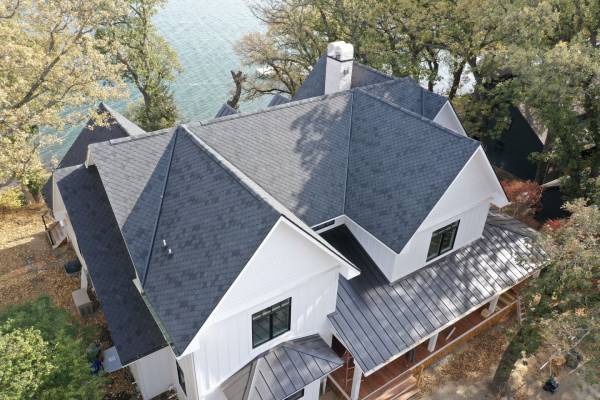Strong winds, heavy rain, and hail can weaken a roof without leaving obvious signs. Missing shingles and visible leaks are easy to spot.
However, hidden damage can create bigger issues over time. A professional storm damage roof inspection finds problems before they lead to costly repairs. Trained specialists check every part of the roofing system to make sure it holds up against future storms. Small cracks, loose materials, and weak spots need attention to prevent worsening conditions.
Even if the roof looks fine from the ground, unseen damage may be present. Here is what a thorough roof inspection covers.
Inspecting Roof Shingles for Hidden Damage
Shingles serve as the first line of defense against severe weather. Wind, hail, and heavy rain can loosen or crack them. This allows water to reach the underlayment.
Some damage remains hidden because it does not cause immediate leaks. Inspectors look for lifted edges, granule loss, and impact marks from debris. Granules protect shingles from UV rays, and their loss speeds up deterioration. Cracks or dents indicate weakened spots that may lead to leaks.
Hail and strong winds can loosen nails and make shingles vulnerable to displacement. Even if shingles remain in place, they might not be secure enough to withstand another storm.
Curling, blistering, or splitting are warning signs that require attention. An expert inspection identifies these issues and determines if repairs or replacements are needed. Ignoring minor problems can lead to costly structural damage over time.
Checking Gutters and Downspouts for Issues
Gutters direct rainwater away from the roof and foundation, preventing water damage. Storms can clog them with debris. This causes overflow which leads to leaks and structural issues. Inspectors check for blockages, sagging sections, and loose fasteners. Clogged gutters force water to back up under the shingles. This leads to rotting wood and mold growth. Proper drainage keeps the roofing system intact by preventing water accumulation.
Heavy rainfall and high winds may loosen gutter brackets or separate joints. Downspouts must also remain clear to assure proper water flow. Inspectors look for dents, cracks, and disconnected sections that could affect performance.
Storm debris, such as leaves and twigs, needs removal to prevent overflow. Well-maintained gutters and downspouts extend the life of a roof by keeping water away from vulnerable areas.
Examining Flashing Around Roof Openings
Flashing seals gaps around chimneys, vents, skylights, and other roof penetrations. Storms can loosen or crack these metal strips, creating entry points for water.
Inspectors check for rust, separation, and bent sections that may allow moisture to seep in. Even minor gaps can lead to interior water damage, mold growth, and weakened insulation. Flashing failures often go unnoticed until leaks appear inside the home.
High winds can lift flashing–breaking the seal that keeps water out. Storm-driven debris may dent or puncture metal, reducing its effectiveness. Inspectors assess its condition and make sure it remains securely attached.
Proper sealing around roof openings protects against leaks and strengthens the overall structure. Replacing damaged flashing prevents costly interior repairs caused by unnoticed water infiltration.
Assessing Roof Decking for Structural Weakness
The roof decking serves as the backbone of the entire roofing system, providing crucial support for shingles and underlayment. When storm damage compromises this layer, the roof loses its ability to maintain structural integrity.
Water damage is one of the biggest threats to roof decking, as moisture weakens the wood. This makes it prone to sagging or even collapsing. Inspectors look for soft spots, mold growth, and signs of rot that indicate long-term water exposure.
Hidden leaks allow moisture to accumulate over time. This breaks down the decking material and reduces its load-bearing capacity. Identifying these issues early helps homeowners avoid extensive structural damage and costly replacements.
Storm impact, high winds, and heavy rainfall put immense stress on the roof decking. While surface damage like missing shingles is easy to spot, underlying issues may go unnoticed without a professional inspection. Inspectors check for warping, bowing, or discoloration–which signal weakened areas that need reinforcement or replacement.
Water stains on interior ceilings often point to a compromised decking structure. If left untreated, these weakened areas can spread, leading to sagging roofs, weakened rafters, and eventual structural failure. Addressing problems promptly keeps the roof strong and prevents widespread deterioration.
A solid roof decking foundation assures the entire roofing system remains intact during severe weather conditions. Proper ventilation and moisture control play a key role in maintaining its durability. Without proper airflow, trapped humidity can accelerate wood decay, even in areas that have not suffered direct storm damage.
Identifying Water Leaks and Interior Damage
Hidden leaks can cause significant problems before they become noticeable. Water seeps through cracks in shingles, flashing, or underlayment, reaching interior structures.
Inspectors check ceilings, walls, and insulation for discoloration, peeling paint, or soft spots. These signs indicate prolonged moisture exposure. This can lead to mold growth and weakened materials. Even small leaks can cause major structural issues if left unattended.
Storm damage often results in leaks that follow hidden pathways. Water may enter at one point but appear at another, making detection difficult. Inspectors trace water stains and damp areas to their source. They guarantee all affected spots receive proper attention.
Early identification prevents costly repairs and protects against mold, mildew, and rotting wood. Addressing leaks immediately helps maintain the home’s structural integrity and indoor air quality.
Evaluating the Attic for Moisture Buildup
An attic plays a key role in maintaining proper roof ventilation and insulation. When excess moisture builds up in this space, it often signals underlying roof damage that may not be visible from the outside. Inspectors check for damp insulation, mold growth, and condensation on rafters or beams.
Any sign of trapped moisture weakens wooden structures and leads to long-term deterioration. Wet insulation loses its effectiveness and makes it harder to regulate indoor temperatures. This results in higher energy bills as heating and cooling systems work harder to maintain a comfortable environment.
Poor ventilation further worsens the problem by allowing humidity to linger. This can create an ideal environment for mold and mildew to spread.
Storm damage significantly impacts attic conditions by allowing water to seep through cracks in the roof. Inspectors look for wet spots, musty odors, and rusted nails, all of which indicate excessive humidity. Moisture buildup inside the attic can go unnoticed for months–weakening the home’s structural integrity.
Without proper airflow, condensation accumulates and leads to wood rot and ceiling stains. Addressing attic concerns early prevents mold-related health issues and preserves the roof’s durability.
Documenting Damage for Insurance Claims
Insurance companies require clear and detailed proof of storm damage before they approve repair claims. Inspectors gather evidence by taking photos, noting affected areas, and providing written assessments. This documentation makes sure that both visible and hidden damage is accounted for.
Missing or cracked shingles, dented flashing, and water stains all serve as proof of storm impact. A well-prepared report strengthens an insurance claim and increases the chances of full coverage for necessary repairs.
Waiting too long to file a claim can lead to complications. Delays may result in denied coverage or out-of-pocket expenses. This makes timely documentation important. Inspectors assist homeowners by gathering all necessary information to submit an accurate and detailed report. Insurance adjusters rely on professional assessments to determine repair costs and approve claims.
Without sufficient proof, homeowners may receive lower payouts or have their claims rejected entirely. Proper documentation speeds up the claims process and guarantees homeowners get the financial support needed for storm-related repairs. A thorough inspection report helps homeowners receive fair compensation–avoiding unnecessary repair costs.
Determining Roof Repair or Replacement Needs
After a storm damage roof inspection, roofing specialists evaluate the extent of necessary repairs. Minor issues, such as a few missing shingles or small leaks, may only require patching or reinforcement.
However, widespread damage, structural weakening, or extensive material loss may require a full roof replacement. The decision depends on factors like the roof’s age, material condition, and the likelihood of further deterioration. Inspectors provide homeowners with a clear understanding of what repairs are needed to restore roof integrity.
Ignoring damage can lead to more severe issues. A weakened roof may not withstand the next storm. This increases the risk of interior leaks, mold growth, and costly repairs. Small problems, such as lifted shingles or minor leaks, often develop into major structural failures if left unaddressed. Roofing professionals recommend timely interventions to prevent escalating costs.
Homeowners who act quickly can avoid expensive repairs and extend the life of their roof. A well-maintained roof protects against harsh weather conditions. Choosing the right course of action keeps the home secure while maintaining property value.
Choosing a Trusted Roofing Contractor Locally
Storm damage requires immediate attention. However, choosing the right roofing contractor makes all the difference. Not all roofers deliver quality work. Hiring the wrong one leads to unnecessary expenses and future problems. A reliable professional offers expertise, proper materials, and a thorough inspection process.
Experience and Certification
A well-established contractor with years of experience understands local weather conditions and common roofing issues. Proper licensing and certifications indicate adherence to industry standards.
Insurance coverage protects homeowners from liability in case of accidents or damage during repairs. Experienced roofers provide warranties on materials and workmanship.
Local Reputation
Community feedback and online reviews reveal a contractor’s reliability. A trusted roofing professional has a history of satisfied customers and verifiable references.
Local contractors understand regional building codes and climate challenges. Choosing a well-reviewed company reduces the risk of poor workmanship or project delays.
Detailed Inspection and Estimate
A professional contractor conducts a thorough assessment before recommending repairs or replacement. A clear estimate outlines labor, materials, and potential additional costs.
Transparency in pricing prevents hidden fees and unexpected expenses. Contractors who rush the process or offer vague quotes may lack the necessary expertise.
Emergency Response and Availability
Storm damage requires quick action to prevent further issues. A responsive contractor offers emergency services and prompt repairs. Reliable roofers maintain open communication and keep homeowners informed throughout the process. Delayed repairs lead to worsening damage, increasing costs in the long run.
Schedule a Storm Damage Roof Inspection with Harveys Five Star Roofing
Hidden roof damage gets worse over time, leading to costly repairs and interior issues. A storm damage roof inspection finds weak spots before they turn into serious problems. Our experts check shingles, flashing, gutters, and attic spaces to assure your roof stays strong. We assess structural integrity, document damage for insurance claims, and recommend the best repair solutions.
Harveys Five Star Roofing delivers fast, reliable service when storms hit. Our storm damage roofing contractors in Sioux Falls handle everything from minor repairs to full roof replacements. We work within your budget, using quality materials to restore your home or business quickly.
As trusted local professionals, we keep communication clear and get the job done right the first time. Call Harveys Five Star Roofing today to schedule an inspection and protect your property from further damage.









